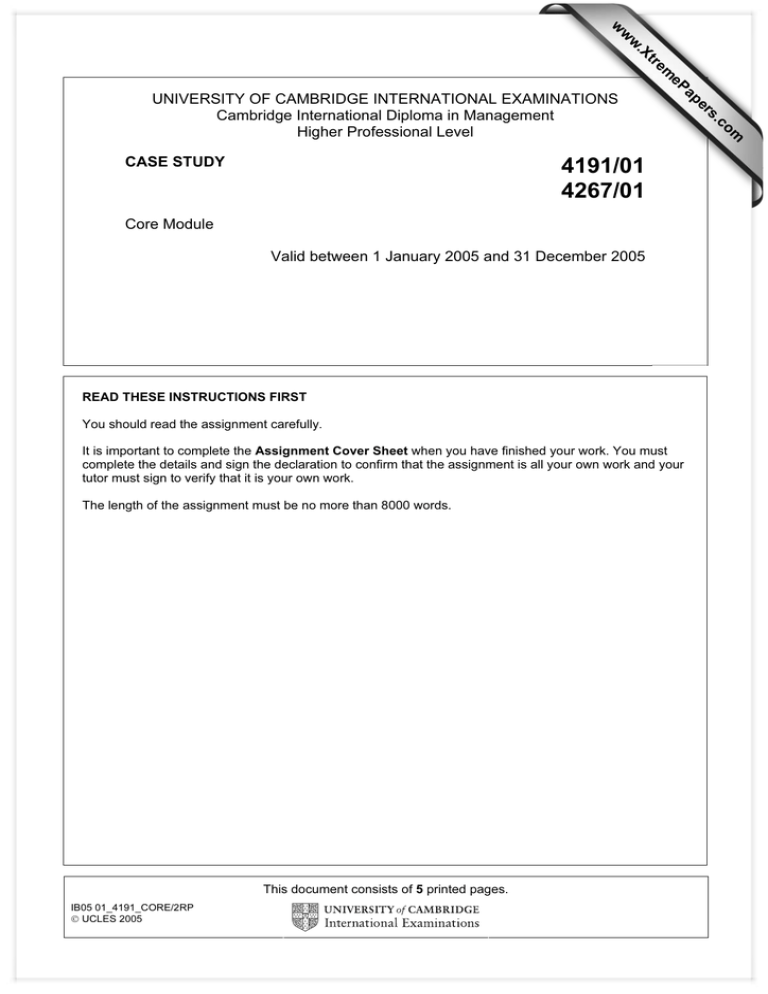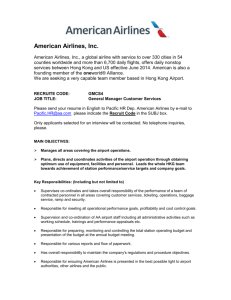www.XtremePapers.com
advertisement

w w ap eP m e tr .X w Core Module Valid between 1 January 2005 and 31 December 2005 READ THESE INSTRUCTIONS FIRST You should read the assignment carefully. It is important to complete the Assignment Cover Sheet when you have finished your work. You must complete the details and sign the declaration to confirm that the assignment is all your own work and your tutor must sign to verify that it is your own work. The length of the assignment must be no more than 8000 words. This document consists of 5 printed pages. IB05 01_4191_CORE/2RP UCLES 2005 om .c 4191/01 4267/01 CASE STUDY s er UNIVERSITY OF CAMBRIDGE INTERNATIONAL EXAMINATIONS Cambridge International Diploma in Management Higher Professional Level 2 Case Study - Core Module Title: Albion Airlines Albion Airlines is an entirely UK-owned, low cost passenger airline, flying out of one of the airports around London. It has been in operation for four years and has had considerable success in establishing itself as a business and leisure carrier to European towns and cities. Now that the airline has an established customer base, it is looking to expand its business and wishes to fly into an airport in your locality. The airport would need to be large enough to manage the Boeing 737200 passenger jet, with a seating capacity of 200. The airline initially wishes to fly four return services each week from the UK, with a planned expansion to daily return flights after 12 months, depending upon its success. Operational strategy In common with other low cost UK and US airlines, Albion Airlines will operate a ‘spiderweb’ system, rather than the more traditional ‘hub and spoke’ used by the major and long haul airlines. The ‘hub and spoke’ structure means that airlines fly large planes into major airports (‘hubs’) and link up with smaller airports (‘spokes’) using smaller planes. Passengers buy tickets for the whole journey and the airline is responsible for ensuring continuity of travel at connection points. With the ‘spiderweb’ structure, airlines use smaller planes and link from one airport to another, without having their own infrastructure at any one airport. Passengers are responsible for ensuring their connections are maintained, and buy each strand of the journey separately. This keeps resource allocation flexible and widespread, allowing an airline to concentrate its assets on passenger transport, outsourcing the infrastructure from airport authorities and other airlines at the point of need and use. This strategy has served Albion Airlines well within its European operations. Flight times for each strand are rarely above 60 minutes and the ‘spiderweb’ structure allows passengers to move across Europe from one small airport to another using Albion Airlines’ frequent service between them. The airline now realises it needs to reconsider its strategy as it moves into new markets, including your locality, which may be more than 60 minutes’ flying time from the UK hub. The acceptable limit for each strand of a flight is 1,500 kilometres. If your local airport is further away from the UK hub than this, then one or more further strands must be scheduled with other airports. From the beginning, Albion Airlines' strategy was to offer no-frills, low-cost flights to underused and noncrowded airports away from major cities. This included no baggage transfers, no meals, no assigned seats and reusable boarding cards. Passengers would book through the Internet or show up at the airport at a given time and purchase a machine-printed ticket for the next available flight. The reason behind the no-frills policy was that there were other things to offer customers that gave better value; for example, frequent, reliable on-time flights at low prices. By using underused, smaller, regional airports, with flight times and landings early in the morning and late at night, airport fees were dramatically reduced. © UCLES 2005 4191/01, 4267/01 2005 3 Costs strategy One way the airline has been able to keep its costs down is through subcontracting for support services such as major maintenance, data processing and legal services. It also subcontracted for airport support services and jet fuel supply. This policy has allowed it to source best prices at a given time, to contract for services at point of use and not to have assets tied up and idle when not being used. There are risks associated with such a strategy, not least those around supply and demand of the services in question. Nevertheless, the strategy has served the airline well during its European operation. Its average number of flights for each plane for each day is 7.5, whereas the industry average is 4.5. Its planes are in the air 11 hours each day, rather than the industry average of eight hours each day. As the flights are generally shorter than those of the major airlines, and use more fuel, Albion Airlines is proud of its cost of US$1.5 for each available seat mile, one of the lowest of the European airlines. The secret is that it made the best use of its main assets, its planes. Because of the focus the airline is able to give, during the time its planes are on the ground, to refuelling, baggage handling and servicing, it is able to speed up turnaround times for the planes, and is able to deliver a consistent turnaround time of 30 minutes. This allows it to book take off and landing times with these smaller airports during the day, and so it achieves high passenger numbers with a relatively small fleet of 15 planes. This means it can operate the ‘spiderweb’ profitably, flying from one small airport to the next, ferrying passengers all over Europe, with its planes almost continuously in the air. The airline also has achieved one of the lowest staff to plane ratios in the business, with an average of 40 employees for each plane. The airline is aware that such a strategy may not be applicable for longer haul journeys to your locality and it may have to review this. The overall strategy has these factors: • Low turnaround times mean that planes are in the air for a high proportion of the time, carrying passengers and earning revenue. • Because the revenue load can be spread over more airtime seats, ticket costs can be discounted so that more people travel with Albion Airlines. • Low fixed assets on the ground and low staff numbers means low overheads: all aircraft services are subcontracted where possible and passenger services are automated or minimised. Again, this leads to lower fares. • All this leads to a high annual average seat occupancy level of 75% at an average ticket price of US$80. © UCLES 2005 4191/01, 4267/01 2005 4 New markets The dilemma for the airline is how to continue to grow through increasing market share rather than through acquisition. If the estimates are to be believed, air travel will increase at a high rate over the next 20 years, so there will be a new market. Albion wants to be in a position to capture their share of this, rather than competing with the major airlines for their share of the current market. As well as maintaining and developing relationships with smaller European airports to allow them to set up operations, they also have an eye on different markets and that is why they are looking at your locality. The ethos and strategy will need to remain fundamentally the same in any new market sector: low-cost, using smaller (and therefore cheaper) airports, subcontracting services and staff, using non-labour intensive high-tech and low-tech booking procedures, no-frills and quick turnaround of aircraft. The company is aware, however, that such a strategy may need to be amended in the light of the current situation at your chosen airport. The airline may, for example, have to establish its own infrastructure at the airport, with staff and services. The ‘spiderweb’ and low turnaround may not be workable and it may have to follow the example of others and operate dedicated return flights only, back to the UK hub. It may be that the business and tourism market in your area is not strong enough to support the same high level seat occupancy that it is currently gaining in Europe and this may affect the pricing structure. It may be possible to work with local businesses to share costs, as the airline will be increasing the business and tourism trade, which should benefit local businesses of all kinds including hotels, restaurants, as well as improving communication links for non-tourism business. Sponsorship should be considered as a way of covering initial and ongoing costs for the new venture. With each new plane costing in the region of US$3.5 million, the airline will be in no hurry to purchase new fleet in the short term. This means that the new routes to your locality may have to be resourced from the existing assets or alternative sources in the short term until a case for long-term profitability can be made. © UCLES 2005 4191/01, 4267/01 2005 5 The Task The airline has come to you for help with research, financial planning and managerial strategy, particularly because of your local knowledge. You are asked to consider the airport facilities in your locality and to research the following: • Costs associated with operating flights to and from London, including airport charges, aircraft and passenger support services and fuel • Information that the airline should keep in order to track and monitor its progress through this first year of operation and how it should be managed • The break even passenger numbers for the next 12 months on the basis of the existing fee revenue • Further possible sources of revenue from sponsorship and partnerships with local businesses • Local issues which may affect the viability of such an operation, such as competition with other airlines, demand for such a service, environmental concerns, transport infrastructure and accessibility to the airport From this information, prepare a strategic plan for the owners of the airline to cover the next 12 or 24 months. The plan should suggest operational, pricing, staffing and resourcing strategies, in line with and including the information you have researched. It should also contain an overall financial strategy with at least two options for growth, depending upon variation in actual revenue and expenditure. You should detail any assumptions you have made for this. You should show how you have appraised the financial investment and profitability of the proposals. Within the plan, there should be at least one indication of how Albion Airlines will be able to gain a competitive advantage over its rivals and what changes it will need to make (if any) in order to capitalise on this. Detail your research methods, the information obtained and how you evaluated and analysed it to come to your conclusions. Your report should be addressed to the directors of Albion Airlines. Information about Albion Airlines which is not given may be assumed and all such assumptions should be justified. In writing the report, you should adopt an appropriate business format and show how knowledge and understanding of general management strategic and financial planning have been applied. You should include your research methodology in your report. Indicate the number of words used at the start of your report. © UCLES 2005 4191/01, 4267/01 2005



